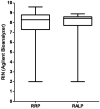Biobanking of derivatives from radical retropubic and robot-assisted laparoscopic prostatectomy tissues as part of the prostate cancer biorepository network
- PMID: 24115205
- PMCID: PMC4020427
- DOI: 10.1002/pros.22730
Biobanking of derivatives from radical retropubic and robot-assisted laparoscopic prostatectomy tissues as part of the prostate cancer biorepository network
Abstract
Background: The goal of the Prostate Cancer Biorepository Network (PCBN) is to develop a biorepository with high-quality, well-annotated specimens obtained in a systematic, reproducible fashion using optimized and standardized protocols, and an infrastructure to facilitate the growth of the resource and its wide usage by the prostate cancer research community. An emerging area of concern in the field of prostate cancer biobanking is an apparent shift in the proportion of surgical procedures performed for prostate cancer treatment from radical retropubic prostatectomy (RRP) to robot-assisted laparoscopic prostatectomy (RALP). Our study aimed to determine the potential impact of the RALP procedure on the detection of known prostate cancer biomarkers, and the subsequent suitability of RALP-derived specimens for prostate cancer biomarker studies.
Methods: DNA and RNA were extracted from RRP and RALP specimens. Quality assessment was conducted using spectrophotometric analysis and RNA was analyzed for RNA integrity number (RIN) and by real-time reverse-transcription PCR (qRT-PCR) for racemase, hepsin, ERG, TMPRSS2-ERG gene fusions, and the microRNAs miR-26a, miR-26b, miR-141, and miR-221.
Results: We demonstrate that extraction of derivatives from frozen tissues from RRP and RALP specimens yields samples of equally high quality as assessed by spectrophotometric and RIN analysis. Likewise, expression levels of genes analyzed by qRT-PCR did not differ between RRP and RALP-derived tissues.
Conclusions: Our studies indicate that samples obtained from RALP specimens may be suitable for prostate cancer biomarker studies-an important finding given the current shift in surgical procedures for prostate cancer treatment.
Keywords: DNA; RNA; biobanking; biomarker; biorepository; prostate cancer.
© 2013 Wiley Periodicals, Inc.
Figures





References
-
- Vaught JB. Biorepository and biospecimen science: A new focus for CEBP. Cancer Epidemiol Biomarkers Prev. 2006;15(9):1572–1573. - PubMed
-
- Esgueva R, Park K, Kim R, Kitabayashi N, Barbieri CE, Dorsey PJJ, Abraham C, Banerjee S, Leung RA, Tewari AK, Terry S, Shevchuk MM, Rickman DS, Rubin MA. Next-generation prostate cancer biobanking: Toward a processing protocol amenable for the International Cancer Genome Consortium. Diagn Mol Pathol. 2012;21(2):61–68. doi: 10.1097/PDM.1090b1013e31823b31826da31826. - DOI - PMC - PubMed
-
- Kerger M, Hong M, Pedersen J, Nottle T, Ryan A, Mills J, Peters J, Moon D, Crowe H, Costello A, Corcoran N, Hovens C. Microscopic assessment of fresh prostate tumour specimens yields significantly increased rates of correctly annotated samples for downstream analysis. Pathology. 2012;44(3):204–208. - PubMed
-
- Carmignani L, Picozzi S, Casellato S, Bozzini G, Marenghi C, Macchi A, Lunelli L, Rubino B, Clemente C. A proposed new technique in prostate cancer tissue bio-banking: Our experience with a new protocol. Pathol Oncol Res. 2012;18(3):663–668. - PubMed
-
- Brimo F, Sircar K, Chevalier S, Saad F, Lacombe L, Têtu B, Scarlata E, Aprikian A. Banking of fresh-frozen prostate tissue using the alternate mirror image protocol: Methods, validation, and impact on the pathological prognostic parameters in radical prostatectomy. Cell Tissue Bank. 2012;13(4):631–638. - PubMed
Publication types
MeSH terms
Grants and funding
LinkOut - more resources
Full Text Sources
Other Literature Sources
Medical

